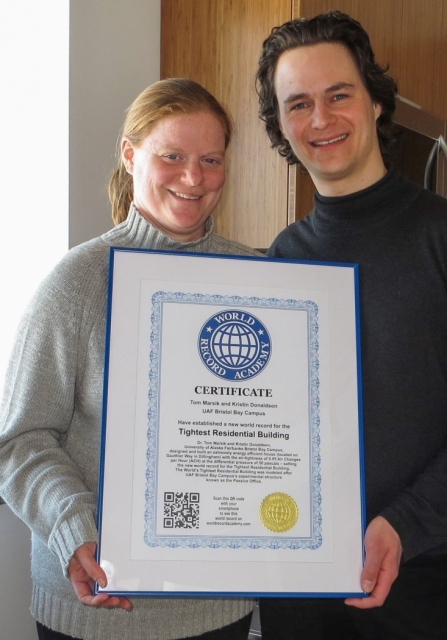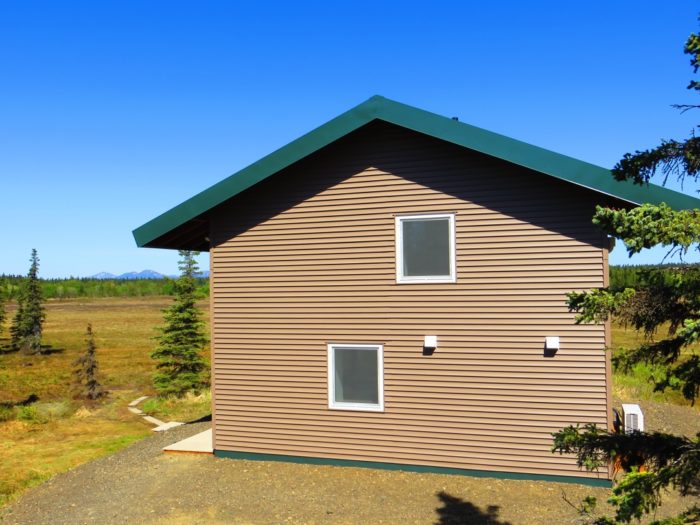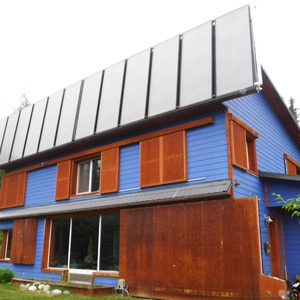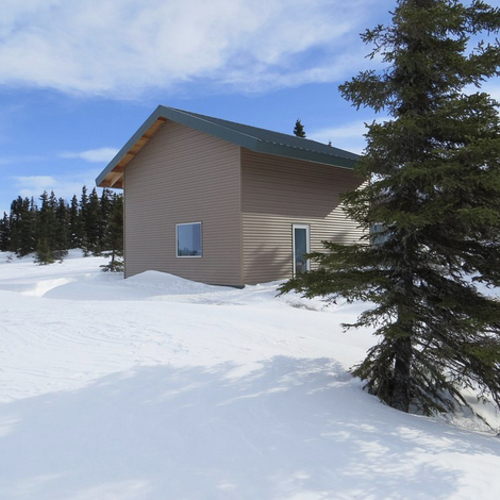Image Credit: Kristin Donaldson
Image Credit: Kristin Donaldson The house has only three windows, plus a door that's mostly glass, but the use of high visual transmittance glass and light-colored paint on walls and ceiling keeps the interior bright. There are two bedrooms, including a sleeping loft. The house has inner and outer walls with the space in between filled with cellulose insulation.
The house in Dillingham, Alaska, that was crowned the tightest residential building in the world is for sale.
Tom Marsik and his wife Kristin Donaldson, who completed the two-bedroom house in 2012, are moving so Marsik can take a new job as director of research at the Cold Climate Housing Research Center in Fairbanks, 500 miles to the north. They’re offering the house for $299,000.
The new owners won’t have to worry about the cost of heating the house, even if it’s located in a climate with about 11,000 heating degree days a year. With a roof insulated to R-140 and 28-inch-thick walls, the all-electric house was designed to be heated mostly with internal gains — appliances, body heat, and lighting — plus a little passive solar heat. But its real claim to fame is a blower-door test that measured its air leakage at an astonishing 0.05 air changes per hour at a pressure difference of 50 pascals. By way of comparison, the Passivhaus standard allows 0.6 ach50.
Marsik is an associate professor of sustainable energy at the University of Alaska at Fairbanks’ Bristol Bay Campus who wanted to prove that a combination of a very small footprint and “super-efficient construction technology” could result in extremely low energy use.
Weekly Newsletter
Get building science and energy efficiency advice, plus special offers, in your inbox.
He’s done that in spades. Although there’s nothing exotic about the building materials the couple used — wood framing, cellulose insulation, Energy Star appliances — the extremely tight building envelope and copious amounts of insulation mean that the house can be heated with about $15 worth of electricity per month.
The house, overlooking Scandinavian Creek and an expanse of tundra, has two bedrooms and one bathroom on a 24-foot by 24-foot footprint. It’s built something like a house with double-stud walls except that the distance between the inner and outer walls is much greater, allowing for R-90 worth of cellulose insulation. The depth of the insulation in the roof assembly is about 3 feet.
The house has three fiberglass-framed windows with triple glazing, an exterior door that’s mostly glass, and a heat-recovery ventilator.
Living in a cozy box
In an article for Alaska Building Science News, Marsik wrote that from January 1, 2012 through the end of April that year, the house used 1,620 kWh of electricity, or only about 400 kWh a month for heat, lights, hot water, and appliances. Modeling had predicted the house would use 1,520 kWh over the same four-month period. Marsik said the small discrepancy could be explained by an unusually cold winter that year.
“It is interesting to point out that our house uses less electricity than an average house in Dillingham,” Marsik’s article said. “This, coupled with the fact that our house uses no heating fuel, results in a significantly lower energy bill.” Marsik calculated savings at $4,000 a year when compared to an average house in town, but it could be even more as energy costs go up in the future.
At the time, heat came from a simple electric-resistance heater. That’s since been replaced with a Fujitsu RLS 3H series minisplit with an output of 12,000 Btu per hour.
Marsik wrote that his approach to building had pros and cons. Benefits include low energy use, a healthy indoor environment, and the safety of burning no fossil fuels or wood. On the downside, the cost of insulation itself was about $20,000.
“A thorough economic analysis hasn’t been done yet,” he wrote, “but the payback period on the extra costs isn’t going to be super short. However, a well built-home is likely going to last for a very long time, and given all extra benefits to society through a reduced consumption of fossil fuels, I think the extra initial investment is well worth it.” (Many details about the house, including photos taken during construction, are available at this page at Alaska Energy Wiki.)
Reached by phone, Marsik said this week that he and his wife, who now have a 4-year-old daughter, are sorry to give up the house.
“It’s amazing,” he said. “We love it. My wife asked whether he can just get a helicopter and move it.”

Although the house has only three windows, Marsik said they were custom-built and have glass with high visible transmittance of light. That plus the use of brightly painted walls and ceilings give the house excellent day-lighting.
The house has a total of about 1,150 square feet when you include the second-story loft bedroom (the total is what an appraiser would call the “gross living area”), Marsik said, and that’s been plenty for the three of them and their dog. “It’s more than we need,” he said.
Marsik is a proponent of space efficiency and does not think that people living in much bigger houses are any happier than people living in small ones. In fact, he said, a United Nations happiness report found that in many European countries where apartments and houses are much smaller than in the U.S. people are, on the whole, happier. Smaller houses mean less maintenance and less cleaning, leaving time for intrinsically more rewarding activities.
Still looking for the right buyer
The house has been on the market, off and on, since Labor Day of last year. Although the couple has hosted an open house and quite a number of individual visits from potential buyers, they have yet to get a single offer. They’d prefer selling the house to someone who is as interested in sustainable design as they are.
“We want the house to continue being an example of sustainable housing, and so in light of that we are willing to go significantly down on the price,” Marsik said. “But nobody has given us an offer yet.”
When they do sell the house and move to Fairbanks, the couple will have to decide whether to build again. “We are going to explore options,” he said. “Building a new home is certainly one of the options on the table, but I don’t want to make a decision yet because we want to get familiar with the local situation first.”
Should they build, Marsik says the design would vary little from what they already have. Fairbanks is colder than Dillingham — about 14,000 heating degree days a year — and the basic components of the current house would probably work well there. Whatever adjustments they make in design would most likely be to take advantage of technology that has become available since they originally built six years ago.
For example, they have a vented clothes dryer now because unvented heat pump clothes dryers were not available at the time. Now they are.
Other than that, Marsik sees little to change.
Note: The caption of the first photograph has been edited to clarify the size of the house.














25 Comments
Air-Sealing Strategy
Does anyone know what method they used? As I recall, the current tightest house used poly.
Air-sealing
Malcolm,
The house is designed as a box within a box. The article Tom Marsik wrote for Alaska Building Science News says a plastic vapor barrier was applied to the outside of the inner box. He said this allows wiring and plumbing to be installed without puncturing the vapor barrier.
What a home!
Thanks so much for sharing this home with the GBA community. The flickr photos go to show how innovative and yet simple this home really is.
Some observations:
1.) Looks like the the floor is bare soil/EPS/poly/ floor joist and then subfloor. Wow!
2.) They used spray foam around the windows and still broke the air tightness record. Makes you question the use of extremely expensive expanding tapes used for some passivhauses.
3.) I still can't figure out how the exterior walls are supported. I realize they are not load bearing but do they have their own footings/ piers?
4.) Quick note to author: According to the photos- they installed a Mitsubishi mini split not a Fijistsu. Perhaps they changed it?
Minisplit
Rick,
Tom said he's gone through two minisplits, the latest being the Fujitsu.
Nope
That's a spectacularly ugly house. Three windows?
very impressive
Only 20K for insulation does not seem terrible at all. At 4K savings a year thats 5 years to payback, thats incredible. That said i hope low impact insulation predominated, cellulose is good but if it were all foam or closed cell spray foam that would not be sustainable for large scale adoption plus the extra material used, sounds like they almost used two houses of material in total (including wood).
I am curious about the annual heat and electricity numbers though.
It's only 576 sq ft, so the
It's only 576 sq ft, so the glass area is OK. I'd be interested in knowing their rate per kwh to get a better handle on how much power is used for heating.
What a bargain at only $500
What a bargain at only $500 per square foot.... only about 5 times per square foot the average cost in Alaska
And for that you get to live in cooler
576 sq ft is small
576 sq ft is small but when you shrink in size layout becomes much more important and can make or break a house. I am curious what its layout is, the pictures in the wiki are too small to read details.
Response to Rick Evans (Comment #3)
Rick,
Q. "I still can't figure out how the exterior walls are supported. I realize they are not load bearing but do they have their own footings/ piers?"
A. There are concrete footings under the exterior walls. See the illustration below.
.
Response to Alan B (Comment #9)
Alan,
See the floor plans below. Click each of the two images separately to enlarge.
.
@ Martin
Thanks, in the first pic i can't quite make out the bottom right room, whats in it?
Where is the second bedroom, i assume when you enter your going into the dining room and the bottom left room is the living room
Floor short circuit?
The graphic Martin posted shows a complete envelope or cavity isolated from interior walls to the footing, but in the pictures they built the floor system to the exterior wall, then everything else above that is spaced off the exterior wall the 28" so they broke the continuity of the envelope at the first floor bottom plate, I wonder if they addressed this prior to decking the floor?
Response to Alan B (Comment #12)
Alan,
In the house plans, the top faces north.
I assume that the lower-floor bedroom is the room in the lower left-hand corner (that is, the room in the southwest corner). The other bedroom is the loft bedroom on the second floor.
The room on the bottom right on the first floor (that is, the room in the southeast corner) is the mechanical room, I assume. The labels are hard to read, but I can read these words: "Door, [Something] tank, [Something else] tank, Water softener [I think], HRV."
The photos below provide a few more clues. The photos show a pressure tank for the water supply system, a water softener, a water heater, and a Lifebreath HRV.
It strikes me as odd that the mechanical room was located on the south side of the house. That's unusual. Most Alaskan designers would put the mechanical room on the north side of the house.
.
Scott
I'm a bit slow. That's the same house. I'd never seem pictures of it finished.
More details?
576? I read 1125 sf. "The house has a total of about 1,150 square feet when you include the second-story loft bedroom ..."
All electric for $15/month would be wonderful in my area.
I really enjoyed this article and the wiki article. Is there a more detailed project article (more construction and interior photos, etc?)
Thanks.
Fran
Response to Franchesca Siepenkothen
Franchesca,
The Alaska Energy Wiki page is not just one article. It is a link to many resources.
The page includes links to several pages of Flickr photos, a PowerPoint presentation, and at least 14 published articles about the house.
"But nobody has given us an
"But nobody has given us an offer yet." The most important words in the entire piece. Something is only worth what someone else will pay for it
Tracing the multiple links
Tracing the multiple links shows references to an admission the interior sq ft is 600 or looking at the slide show it is 590 sq ft so again 1150 appears to be the questionable figure.
Multiple links confirm the exterior diminsions as 24 x 24 which is 576 sq ft (without any wall thickness) so at best (after 28" thick walls), the total fist floor sq ft is no more than 375 (including the mechanical space). Even if the "loft" covered the entire first floor. doubling the 375 only gets you to 750 < 1150.
The 600/590 sq ft is the reasonable number.
Note: 28" = 2.333ft x 24 feet x 2 walls = -112 sq ft interior space along 2 walls
24 feet - 2.33ft on each end of the other walls = 19.33 on the other two walls
2.333ft x 19.333 x 2 = -90.22 sq ft on the other two walls
576 - 112 - 90 = 374 sq ft
Also, still a lot of
Also, still a lot of confusion about square footage as that number has now changed to 1150 square feet but the drawings posted show notes of 374 sq ft on the first and 206 sq ft on the loft for a total of 580 sq ft.
Further a 24 x 24 foot print is indeed 576 sq ft less the 28in+ wall leaves you with less 375 sq ft on the first floor (which DOES match the drawing notes) which would mean the loft would have to be 775 sq ft to total 1150.....which would be very interesting to see a loft larger than the first floor. Even if we say the first floor is 576 sq ft , that from 1150 leaves you with a loft area of 574 sq ft which ceases to be a loft as shown but rather becomes an entire second floor with barely a scuttle hole to climb up to the loft.
All of that set aside, I don't believe normal practice is to call a loft a bedroom because it isn't enclosed by walls. By most normal realtor conventions, its a 1 bedroom home of very nebulous square footage available for the low price of $299,000
@ MArtin Thanks, its
@ Martin Thanks, its basically the utility room. You make a good point about the south bearing, perhaps its meant to provide some extra heat to the hot water heat pump :D
If the bottom left is the second bedroom that would mean the other section is either the dining or living room, meaning this house lacks one or the other.
@ Buy Why If its only worth what someone will pay for it then my house is worth zero because i have received no offers in years (having not listed it). Since my house is worthless i am paying a very inflated property tax bill and would love to see my house revalued :D
The worth of something is
The worth of something is determined by the price a WILLING buyer and a WILLING Seller agree upon. You are not a willing selling but your home is not WORTHLESS.
BTW, the easy way to solve the issue of disputed property tax values would be for the taxing bodies to value the properties at market value (not 1/3 of value as is customary in my area.). The state should then pass a law that anyone that disputes the value of the home is effectively offering the home for sale at that price and is subject to the state or anyone else claiming the property for that price. Instantly, you are only going to see the number of property tax appeals and complaints fall off the map. Only the people that are truly way over valued would show up and risk having their property claimed.
sq footage
I think the tax man or the real estate broker used a 24x24 two story house definition, 1152 sq ft.They might be technically obliged.
Was there a conversation here some years ago, about thicker walls and taxes, or maybe it was just in my head....
two minisplits and a heat pump water heater
The minisplits are an expensive choice, considering the small amount of heating. A heat pump water heater sounds like a bad choice, cooling the house to heat water.
This points to an overall situation of spending a lot of extra money for not a lot of gain. Also resulting in so much lost floor space. I have a similar sized house, plus a basement, and my walls are a foot thick. It was a retrofit so did could not increase the space. I gave up some space insulating the walls but recovered space removing the furnace and ducts.
Cool Project!
Not a home for everyone, obviously, but a cool case study/demo that kept the family cozy and healthy for a few years.
Log in or create an account to post a comment.
Sign up Log in